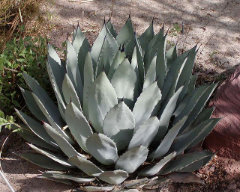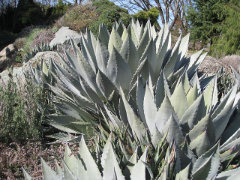 |
|
Creative Commons Attribution-Share Alike 3.0 |
 |
| Brewbooks from near Seattle, USA Creative Commons Attribution-Share Alike 2.0 |
Translate this page:
Summary
Agave palmeri is an evergreen, stemless, succulent plant forming a rather open rosette of leaves that can be 50 - 120cm tall and 100 - 120cm in diameter. The leaves on mature plants can each be 35 - 75cm long and 7 - 10cm wide near the base. After several years of growth, a flowering stem that can be around 3 - 6.5 metres tall is produced, after which the rosette will die. However, the plant occasionally produces a number of young plants around its base that will develop as new plants[1842 , 1844 ]. The plant is harvested from the wild for local use as a food and to make the distilled drink 'mezcal', and also as a source of fibre. Agave palmeri is widely distributed, and it is often abundant where found. Although it faces multiple threats, declines are localised within the larger range. The plant is classified as 'Least Concern' in the IUCN Red List of Threatened Species(2019)[338 ]. The Agave genus, belonging to the Asparagus family (Asparagaceae), includes various species such as Goldenflower Agave, Desert Agave, Palmer’s Agave, Parry’s Agave, and Utah Agave. These plants are historically significant as food sources for Native Americans, who consumed their caudices (crowns, heads, or hearts), flower stalks, flower buds, flowers, and seeds. While these parts are edible, extensive preparation is needed to reduce saponins and irritating soap-like compounds in all of the agave—traditional preparation involves baking the parts in fire pits, enhancing their flavour and texture. The crowns and flower stalks are the most valuable, often baked and consumed immediately or stored for later use. Agave syrup can also be made from the baked crowns.
Agave flowers and seeds are generally not suitable for consumption due to their acrid taste and the presence of potentially harmful compounds. Dislodging agave plants and removing their leaves is labour-intensive, requiring tools like a sharp axe. Agave blooms in late spring to early summer, and its flowers, while not ideal for human consumption, play an essential role in the ecosystem, supporting wildlife. Some agave species are protected, and their collection may be restricted to ensure conservation [2-3].
Physical Characteristics

 Agave palmeri is an evergreen Perennial growing to 1 m (3ft 3in) by 1 m (3ft 3in) at a medium rate.
Agave palmeri is an evergreen Perennial growing to 1 m (3ft 3in) by 1 m (3ft 3in) at a medium rate.
See above for USDA hardiness. It is hardy to UK zone 8. The flowers are pollinated by Bats, Insects, Hummingbirds.
It is noted for attracting wildlife.
Suitable for: light (sandy), medium (loamy) and heavy (clay) soils, prefers well-drained soil and can grow in nutritionally poor soil. Suitable pH: mildly acid, neutral and basic (mildly alkaline) soils. It cannot grow in the shade. It prefers dry or moist soil and can tolerate drought.
UK Hardiness Map
US Hardiness Map
Synonyms
None Known
Plant Habitats
Edible Uses
The plant is used to produce mezcal spirit and bacanora[338 , 1842 ]]. Mezcal is a distilled alcoholic beverage that potentially can be made from almost any species of Agave, though only around fifty are used regularly and seven species are especially favoured. Mature plants are harvested from the wild, their leaves and roots are removed and the remaining 'hearts' are baked (often in an earth oven), then mashed and the resulting liquid allowed to ferment for a few days before being distilled to produce mezcal. The plant is collected both for eating and for making mescal[1842 ]. Various parts of the plant were traditionally eaten. Tthe heart of the rosette, after the roots and leaves have been removed, can be slow-baked for several hours This will convert much of the carbohydrates into sugars and the heart can then be eaten, converted into a distilled liquor (mezcal), dried for later use etc. The best species have a very sweet, syrup-like flavour[1846 ]. The slow-baked leaf bases are also edible, but very fibrous. They are chewed for their sweet flavour, and the fibrous remains spat out[1846 ]. In addition, the young flowering stem can also be cooked and eaten - it has a sweet flavour, though it can be rather fibrous. The flower buds and the flowers can also be cooked and eaten. Many Agave species produce copious nectar when flowering, and this is sometimes collected and drunk. Although sweet, it can be rather nauseous, but it improves if it is boiled and the froth skimmed off[1846 ]. A warning to newcomers to these foods, however - many people find Agaves to be strongly laxative the first few times they eat them[1846 ]. The young, tender, emerging flowering shoots are still eaten in Mexico[1842 ] This species is among the sweeter-tasting members of the genus, with little or no bitter sapogenins reported in assays. The leaves of one sample were found to contain 0.5% hecogenin, whilst several other samples were negative[1842 ]. Parts Used: Caudices (crowns, heads, or hearts), flower stalks, flower buds, flowers, and seeds. Preparation: Extensive preparation is often required. Cooking reduces saponins (irritating soap-like compounds). Harvesting: Crowns can be gathered anytime, traditionally, when flower stalks emerge. Flower stalks are best gathered when they first appear (April to June), while still soft. Traditional Method: Native Americans baked agave flower stalks and crowns in fire pits overnight. Baked parts can be consumed immediately or stored for future use. Agave syrup is made by boiling baked crowns with water [2-3].
References More on Edible Uses
Medicinal Uses
Plants For A Future can not take any responsibility for any adverse effects from the use of plants. Always seek advice from a professional before using a plant medicinally.
None known
References More on Medicinal Uses
The Bookshop: Edible Plant Books
Our Latest books on Perennial Plants For Food Forests and Permaculture Gardens in paperback or digital formats.

Edible Tropical Plants
Food Forest Plants for Hotter Conditions: 250+ Plants For Tropical Food Forests & Permaculture Gardens.
More

Edible Temperate Plants
Plants for Your Food Forest: 500 Plants for Temperate Food Forests & Permaculture Gardens.
More

More Books
PFAF have eight books available in paperback and digital formats. Browse the shop for more information.
Shop Now
Other Uses
The leaves are a source of fibre , used for making cordage etc[338 , 1842 ].
Special Uses
References More on Other Uses
Cultivation details
Agave species are found mainly in the arid and semi-arid regions of southwestern N. America, especially in Mexico. Many species can withstand at least a few degrees of frost and will succeed outdoors in warm temperate climates, but only in drier regions and where soils are very well-drained. Agave species generally require a sunny position, succeeding in most soils of medium fertility so long as they are well-drained. Most species are undemanding about the soil pH, though those found in the wild on limestone soils will grow better in neutral to alkaline conditions. Plants are generally very tolerant of dry conditions and drought[200 ]. Most Agave species are monocarpic, individual rosettes living for a number of years without flowering before sending up an often very large flowering stem and then dying after flowering and setting seed. This species, however, occasionally produces several new rosettes from suckers towards the end of its lifespan, and these new plants will continue to grow after the death of the parent plant[1844 ]. Individual plants take about 7 - 15 years in their native habitat, considerably longer in colder climates, before flowering[11 ]. This species is an important nectar source for the threatened Lesser Long-nosed Bat (Leptonycteris yerbabuenae)[338 ]. Members of this genus are rarely troubled by browsing deer[233 ]. Bloom Time: Late spring to early summer. Wildlife: Flowers are better left for wildlife as they contain acrid compounds, making them unpalatable for human consumption. Environmental Impact: Some species are protected, so gathering may be restricted in certain areas [2-3]. Challenges: Dislodging an agave is difficult and requires tools like a sharp axe. Preparation: Removing leaves to access crowns is challenging due to their toughness and spines [2-3].
References Carbon Farming Information and Carbon Sequestration Information
Temperature Converter
Type a value in the Celsius field to convert the value to Fahrenheit:
Fahrenheit:
The PFAF Bookshop
Plants For A Future have a number of books available in paperback and digital form. Book titles include Edible Plants, Edible Perennials, Edible Trees,Edible Shrubs, Woodland Gardening, and Temperate Food Forest Plants. Our new book is Food Forest Plants For Hotter Conditions (Tropical and Sub-Tropical).
Shop Now
Plant Propagation
Seed - surface sow in a light position, mid spring in a warm greenhouse. The seed usually germinates in 1 - 3 months at 15 - 20°c[133 , 200 ]. Prick out the seedlings into individual pots of well-drained soil when they are large enough to handle and grow them on in a sunny position in the greenhouse until they are at least 15cm tall. Plant out at the beginning of the growing season, and give some protection from the cold for at least their first few winters[K ]. Offsets and suckers can be potted up at any time they are available. Keep in a warm greenhouse until they are well established[200 ]. Bulbils, where produced, are an easy method of propagation. Simply pot them up and plant out at the beginning of a growing season when they are 10cm or more tall.
Other Names
If available other names are mentioned here
Palmer’s Agave
Native Range
Native to: Arizona, Mexico Northeast, Mexico Northwest, New Mexico.
Weed Potential
Right plant wrong place. We are currently updating this section.
Please note that a plant may be invasive in one area but may not in your area so it's worth checking.
Conservation Status
IUCN Red List of Threatened Plants Status : Least Concern

Growth: S = slow M = medium F = fast. Soil: L = light (sandy) M = medium H = heavy (clay). pH: A = acid N = neutral B = basic (alkaline). Shade: F = full shade S = semi-shade N = no shade. Moisture: D = dry M = Moist We = wet Wa = water.
Now available:
Food Forest Plants for Mediterranean Conditions
350+ Perennial Plants For Mediterranean and Drier Food Forests and Permaculture Gardens.
[Paperback and eBook]
This is the third in Plants For A Future's series of plant guides for food forests tailored to
specific climate zones. Following volumes on temperate and tropical ecosystems, this book focuses
on species suited to Mediterranean conditions—regions with hot, dry summers and cool, wet winters,
often facing the added challenge of climate change.
Read More
Expert comment
Author
Engelm.
Botanical References
Links / References
For a list of references used on this page please go here
Readers comment
| Add a comment |
|
If you have important information about this plant that may help other users please add a comment or link below. Only comments or links that are felt to be directly relevant to a plant will be included. If you think a comment/link or information contained on this page is inaccurate or misleading we would welcome your feedback at [email protected]. If you have questions about a plant please use the Forum on this website as we do not have the resources to answer questions ourselves.
* Please note: the comments by website users are not necessarily those held by PFAF and may give misleading or inaccurate information.
To leave a comment please Register or login here All comments need to be approved so will not appear immediately.
|
|